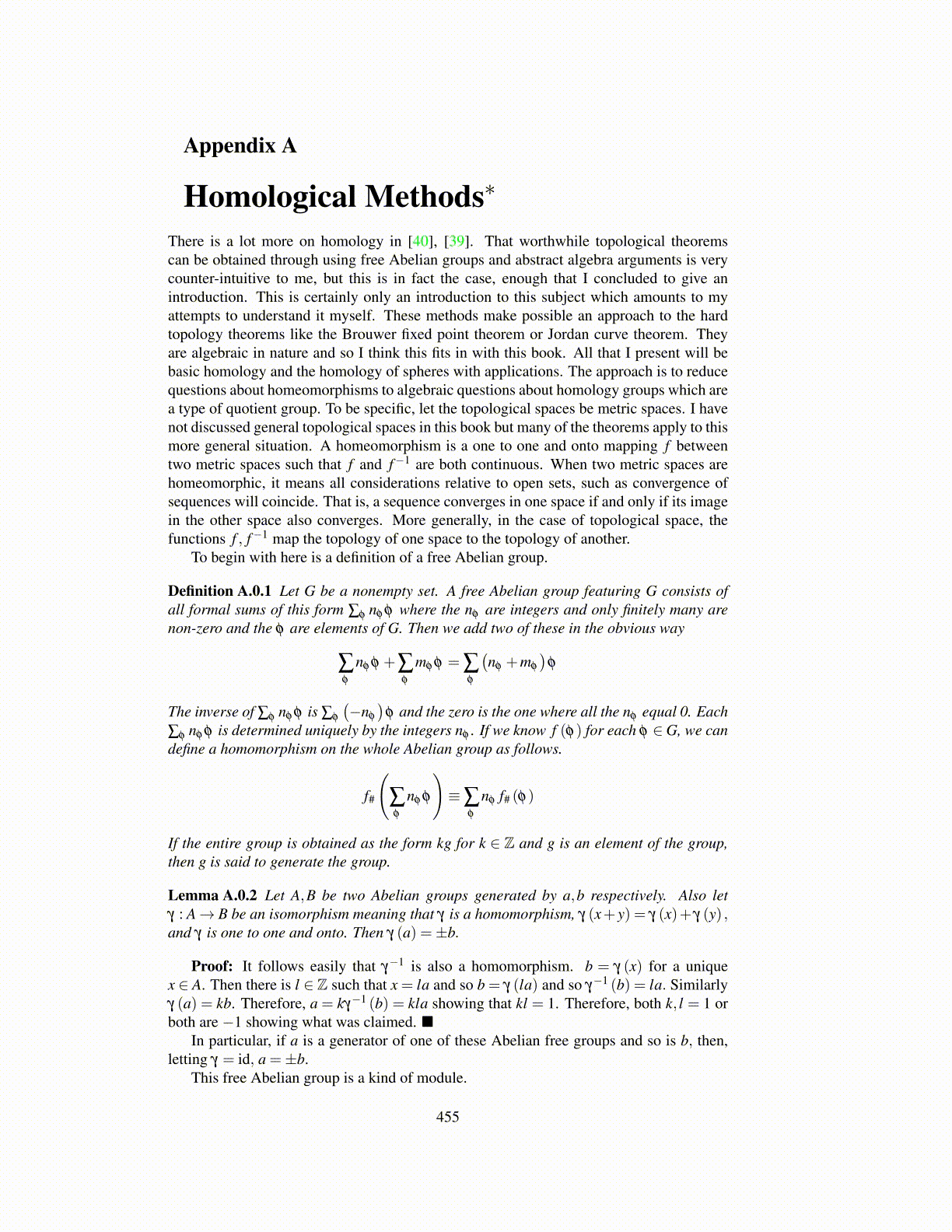
Appendix A
Homological Methods∗There is a lot more on homology in [40], [39]. That worthwhile topological theoremscan be obtained through using free Abelian groups and abstract algebra arguments is verycounter-intuitive to me, but this is in fact the case, enough that I concluded to give anintroduction. This is certainly only an introduction to this subject which amounts to myattempts to understand it myself. These methods make possible an approach to the hardtopology theorems like the Brouwer fixed point theorem or Jordan curve theorem. Theyare algebraic in nature and so I think this fits in with this book. All that I present will bebasic homology and the homology of spheres with applications. The approach is to reducequestions about homeomorphisms to algebraic questions about homology groups which area type of quotient group. To be specific, let the topological spaces be metric spaces. I havenot discussed general topological spaces in this book but many of the theorems apply to thismore general situation. A homeomorphism is a one to one and onto mapping f betweentwo metric spaces such that f and f−1 are both continuous. When two metric spaces arehomeomorphic, it means all considerations relative to open sets, such as convergence ofsequences will coincide. That is, a sequence converges in one space if and only if its imagein the other space also converges. More generally, in the case of topological space, thefunctions f , f−1 map the topology of one space to the topology of another.
To begin with here is a definition of a free Abelian group.
Definition A.0.1 Let G be a nonempty set. A free Abelian group featuring G consists ofall formal sums of this form ∑φ nφ φ where the nφ are integers and only finitely many arenon-zero and the φ are elements of G. Then we add two of these in the obvious way
∑φ
nφ φ +∑φ
mφ φ = ∑φ
(nφ +mφ
)φ
The inverse of ∑φ nφ φ is ∑φ
(−nφ
)φ and the zero is the one where all the nφ equal 0. Each
∑φ nφ φ is determined uniquely by the integers nφ . If we know f (φ) for each φ ∈G, we candefine a homomorphism on the whole Abelian group as follows.
f#
(∑φ
nφ φ
)≡∑
φ
nφ f# (φ)
If the entire group is obtained as the form kg for k ∈ Z and g is an element of the group,then g is said to generate the group.
Lemma A.0.2 Let A,B be two Abelian groups generated by a,b respectively. Also letγ : A→ B be an isomorphism meaning that γ is a homomorphism, γ (x+ y) = γ (x)+ γ (y) ,and γ is one to one and onto. Then γ (a) =±b.
Proof: It follows easily that γ−1 is also a homomorphism. b = γ (x) for a uniquex ∈ A. Then there is l ∈ Z such that x = la and so b = γ (la) and so γ−1 (b) = la. Similarlyγ (a) = kb. Therefore, a = kγ−1 (b) = kla showing that kl = 1. Therefore, both k, l = 1 orboth are −1 showing what was claimed. ■
In particular, if a is a generator of one of these Abelian free groups and so is b, then,letting γ = id, a =±b.
This free Abelian group is a kind of module.
455